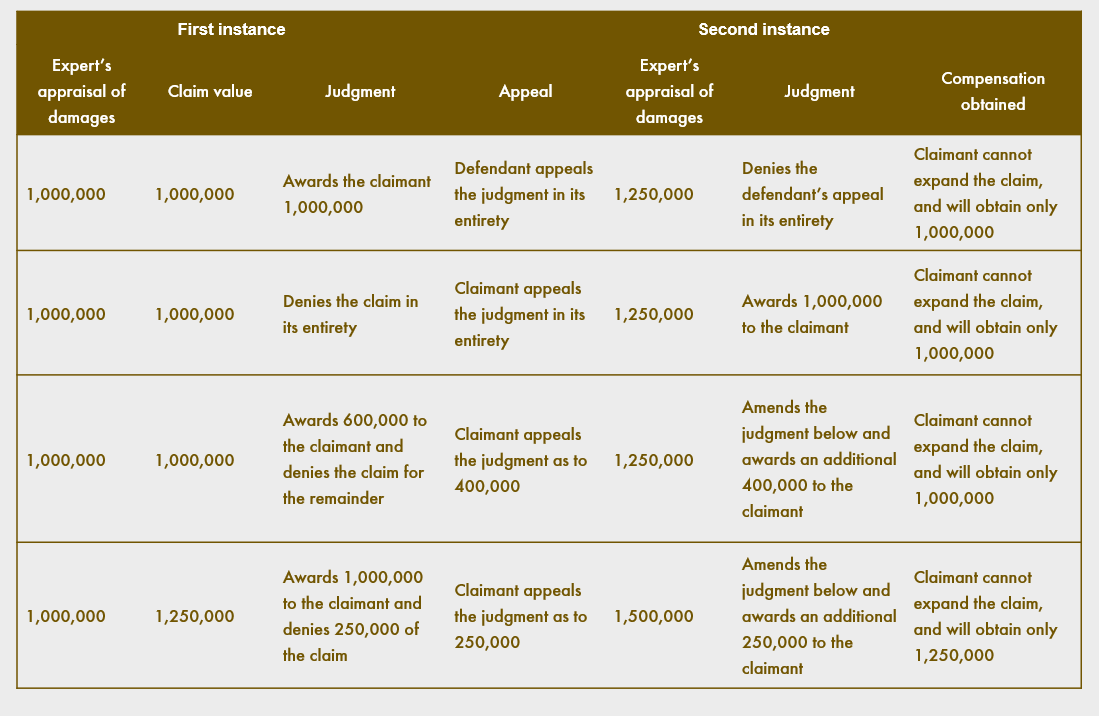Extension of the relief sought on appeal should be more available
For years, the rules limiting the extension of a claim on appeal have been a challenge for counsel determining their litigation strategy when seeking damages in tort cases. Over many years of court proceedings, the value of the claims may change as prices rise. But the Polish courts require the amount of the claims to be frozen as of the time of entering the judgment in the first instance, even though there is a long way before the end of the court dispute.
The Polish Civil Procedure Code limits the admissibility of extending a statement of claim at the stage of the appeal proceedings. The list of situations where this is possible is extremely short. Under Art. 383, in appellate proceedings, the parties cannot expand the claim or relief sought, or raise new claims. But when there is a change of circumstances, the party may demand instead of the original amount in dispute, the equivalent value or other object, or in case of recurring claims, the claim or relief may be extended to cover further periods. This limitation stems from the principle that the subject of the appeal can be, at most, the subject of the proceedings as of closing the hearing before the court of first instance.
Therefore, on appeal, a party cannot make a new claim, change the factual basis of the claim, or expand the claim submitted before the court of first instance. Procedural measures that could alter the claim qualitatively or quantitatively are inadmissible. An analysis of the legal literature and the case law shows that there is little controversy as to the extent to which Art. 383 allows amendments to the claim before the court of second instance.
Claim for damages in tort
But such a rigid interpretation of Art. 383 seems inappropriate with regard to claims for damages in tort. One aspect of tort claims is that at the stage of filing a statement of claim with the court, it is impossible to quantify exactly the compensation due to the injured party. The stated amount should be subject to clarification during the course of the proceedings after the admission of expert evidence. Indeed, if the injury is to be remedied by the payment of money, the amount of compensation should be set based on the prices at the time the compensation is determined, unless extraordinary circumstances require that the prices existing at another time be taken as the basis (Civil Code Art. 363 §2). Often, several years pass between the filing of a statement of claim and entry of judgment, and the values current at the stage of initiating the proceedings are no longer valid at the stage of determining compensation, i.e. at the time of entering the judgment.
The amount of the damages is determined in the course of court proceedings on the basis of the opinion of an expert witness, which must be current as of the date of the court’s ruling. In cases of this type, the determination of the amount of damages is made according to the state of the things or intangibles (associated with the injury) as of the date of occurrence of the injury (often, this is a distant date—sometimes court cases involve injuries from decades earlier), but taking into account the prices of these things or the state of the rights as of the date of preparation of the expert’s opinion. So it is evident that the amount of the damages will depend on the point in the process at which the expert’s opinion is prepared. Situations are not uncommon where in the course of years of proceedings before the court of first instance, the experts’ opinions differ in their estimate of the damages, and one appraisal might be several times higher than the other. While extension of the claim at the stage of the proceedings before the court of first instance is permissible, and the claimant may adjust the amount of damages sought to match that determined in the expert opinion, the procedural situation of the injured party is significantly worsened before the court of second instance.
The appellate court may admit evidence in the form of an expert’s opinion for the purpose of quantifying the damages (when the court of first instance denied the claim for damages) or to verify the amount of damages (when either party appealed the amount of damages awarded). A few years ago, at the Warsaw Court of Appeal a practice developed (which now seems to have been abandoned) of admitting expert testimony in any case where 12 months or more had elapsed since an opinion was issued before the court of first instance. This arose from the recognition that under Art. 156 of the Real Estate Management Act a real estate appraisal remains valid for only 12 months.
Appraisal of the damages at the stage of appellate proceedings can take place many years after the proceedings were instigated, and often two or three years after the judgment of the court of first instance was entered. Usually, these newer appraisals are higher than those prepared before the court of first instance, as they take into account the prices from the date of preparation of the opinion. Currently, in an era of galloping inflation for several years and significant increases in real estate prices, the differences in appraisals are particularly striking. But a higher appraisal does not mean that the injured party may amend the amount sought before the court of second instance in any situation to reflect the reappraisal of the damages.
The table below provides a simplified overview of various procedural situations taking into consideration examples of rulings issued by the appellate courts. The table shows only the methods of ruling illustrating the pitfalls faced by injured parties and their counsel due to changes in the value of damages while litigation is pending.
In all of these cases, the claimant could not expand their claim before the court of second instance beyond the amount sought at the stage of entering the judgment in the first instance, despite the expert’s finding that the damages were higher before the court of second instance. (All amounts in the table are in PLN.)

The procedural stance of the injured party is further complicated when the case goes before the Supreme Court of Poland on a cassation appeal, and the Supreme Court sets aside the judgment of the court of second instance. Then the subsequent damage appraisal when the case is remanded to the court of second instance differs even more from the earlier appraisals, as it takes into account the current, higher prices. But even in this situation, the injured party cannot expand the claim on appeal beyond the amount sought before the court of first instance.
As the table above shows, the injured party has limited possibilities to seek compensation for the full amount of injury in Polish civil proceedings. If the damages are appraised on appeal, the injury will not be redressed to the extent it exceeds the amount sought before the court of first instance—even though the injured party is seeking a single award of damages for the same injury, and only the amount changes over time. The statutory interest for delay awarded to the injured party in the judgment will not always compensate for the underpayment of compensation.
The courts’ rigorous interpretation of Civil Procedure Code Art. 383 is extremely harmful to an injured party who seeks damages in tort. The nature of tort claims and the method of calculating tort damages should be taken into account in the procedural regulations or noted by courts and commentators. The change in the amount of damages during the appeal proceedings as a result of a new appraisal should be interpreted as a change in circumstances that, under Art. 383, should make it possible to expand the claim, because the new appraisal only updates the amount of the damages, and does not change the nature of the injury or its objective scope.
Expanding a claim for buyout of real estate under Art. 36(1) of the Spatial Planning and Development Act
In the judgment of 13 July 2022 (case no. II CSKP 497/22), in a case involving buyout of real estate under Art. 36(1) of the Spatial Planning and Development Act of 27 March 2003, the Supreme Court allowed the claim to be expanded at the stage of the appeal. In that case, the claimant demanded buyout of its real estate due to amendments to the local zoning plan, which rendered the previous use of the property virtually impossible. The claim was not initially granted by the court of first instance, where the value sought for the property was PLN 960,000. The case continued before the court of second instance, which, after admitting expert evidence, set the value of the property at PLN 2,011,032 and also adopted that buyout price in its judgment. Thus, the court of second instance awarded the claimant more than it had ultimately demanded before the court of first instance, and also allowed the claim to be expanded on appeal.
This position was accepted by the Supreme Court, which held: “The existence of the requirement to determine the amount of the buyout price according to the value of the real estate as of the date of the court’s ruling cannot lead to differentiation in the claimant’s situation depending on the stage of the proceedings at which the prerequisites for assessing the current value of the property occurred. Assuming that the buyout price of real estate cannot be updated on appeal, where the current procedural model greatly limits the possibility of issuing a ruling quashing the ruling below, could violate the rights of the real estate owner, who in exchange for the property should obtain an equivalent in the form of a price corresponding to the value of the real estate, similar to the case of expropriation. This dictates a finding that an amendment of the claim in a case of a real estate buyout, consisting in setting the buyout price taking into account the higher value of the property at the time of the ruling by the court of second instance, fulfils the requirement in Civil Procedure Code Art. 383 of a change in circumstances, where the value can be sought instead of the original relief sought in the dispute.”
In cases on buyouts of real estate under Art. 36 of the Spatial Planning And Development Act, the same method of appraising real estate applies as in the case of appraising damages claimed by the injured party in tort. Damages are determined as of the date of entering the judgment. Therefore, if entering the judgment on the amount of the claim takes place before the court of second instance, and the appellate court has updated the value of the damages, then, also in cases seeking tort damages, it should be permissible to expand the claim on appeal.
Conclusion
The ban on extending the claim during appellate proceedings has its justification and in principle is not controversial as such. Art. 383 of the Civil Procedure Code provides for exceptions to this ban, and in their rulings the courts attempt to identify situations where extension of the claim during the appeal is permissible. Such situations should include a change in the quantum of damages during an appeal in a case for tort damages. The injured party should be entitled to compensation in the form of damages in an amount current as of the date of entering the judgment on appeal. Otherwise, the injured party is injured again, and the perpetrator avoids full liability.
Leszek Zatyka, attorney-at-law, State Claims practice, Wardyński & Partners
